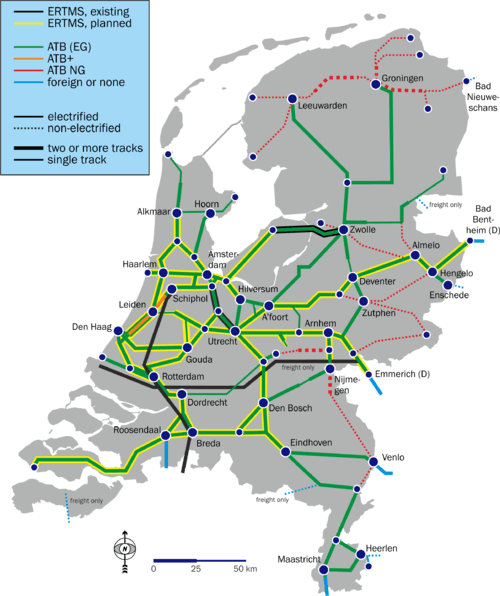Automatische treinbeïnvloeding


Automatische TreinBeïnvloeding or ATB (English: Automatic Train Influencing) is a Dutch train protection system developed in the 1950s. Its installation was spurred by the Harmelen train disaster of 1962.
ATB operates by the train collecting electrical signals from line-side apparatus and will override the driver's controls in the following situations:
- a) failure to reduce speed at a caution signal (ATB will slow the train sufficiently to stop at the next signal).
- b) failure to observe speed limit (ATB makes an immediate emergency brake application)
Speed limits are set in 5 steps: 40 km/h, 60 km/h, 80 km/h, 130 km/h and so-called volle materiaalsnelheid (i.e., full speed allowed for that type of train), which can be 140 km/h at most for non-high speed trains. If the train's maximum allowed speed is lower, the 130 km/h setting is omitted.
Design limitations
One of the early system's design limitations is the inability to enforce restrictions stronger than a speed limit of 40 km/h. Several accidents at train stations and railroad yards occurred because the driver failed to stop at a red signal and ATB did not intervene, as it had already enforced a speed below 40 km/h. Strange as this limitation may seem, there was a reason for it.
ATB works by sending electrical signals through the track. After passing a red signal and entering a section already occupied by another train, the track circuit is shorted by the other train and there is no signal any more. Therefore, the absence of a signal should be interpreted as the most restrictive signal, making the system fail-safe. To allow driving on sections not equipped with ATB or driving on sight onto occupied track, which cannot be discerned from passing a red signal using a system like this, this most restrictive electrical signal was defined as representing a speed limit of 40 km/h. The main purpose of ATB was to prevent overspeeding and failing to respond to yellow signals, as it was deemed unlikely any driver would miss a red signal when already traveling slower than 40 km/h and expecting one. As safety regulations have become stricter over time, it is seen as a problem now.
Another problem is the maximum speed set to 140 km/h. Though there are tracks with a design speed of up to 160 km/h, they cannot be used up to full speed because ATB Eerste Generatie (ATB-EG, ATB First Generation) does not allow this.
Enhancements
To overcome the design flaws, a second generation ATB (ATB Nieuwe Generatie or ATB-NG = ATB New Generation) has been developed which more or less overcomes the aforementioned problems. The speed is now set in 10 km/h intervals from 0 through 200 km/h and the amount of braking is relative to the weight of the train. Though (or maybe because) the early and new systems are totally different and completely incompatible from the design point of view (though a train equipped with ATB-NG also has an ATB-EG system on board, so the system has backward compatibility), they do not interfere with each other: they both can safely be installed at the same track. Also, there are enhancements to the early system, called ATB-Plus (lifts the 140 km/h maximum system speed) and ATB-Plus-Plus (designed to further reduce Stop Tonend Sein or STS-passages = Signals Passed At Danger by applying an emergency brake after passing a signal at danger).
A problem with this new ATB-NG is the patent held by ACEC-Alstom, which does not allow other manufacturers to supply the system and offers poor interoperability with other systems. This is one of the reasons the recently constructed Betuweroute uses the European standard European Train Control System (ETCS).
See also
- Pulse Code Cab Signaling
- Train stop – protects against signal passing at danger
- Automatic Warning System – protects against a)
- Automatic Train Protection – protects against b)
- Train protection system